Ramphastos
Ramphastos is a genus of toucans, tropical and subtropical near passerine birds from Mexico, and Central and South America, which are brightly marked and have enormous, often colourful, bills.[1]
| Ramphastos | |
|---|---|
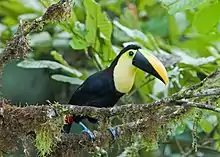 | |
| Choco toucan | |
| Scientific classification | |
| Kingdom: | Animalia |
| Phylum: | Chordata |
| Class: | Aves |
| Order: | Piciformes |
| Family: | Ramphastidae |
| Genus: | Ramphastos Linnaeus, 1758 |
| Species | |
|
See text. | |
| Synonyms | |
| |
Taxonomy and systematics
Extant species
The genus Ramphastos has eight species considered to belong to the genus:[2]
| Image | Common Name | Scientific name | Distribution |
|---|---|---|---|
 | Green-billed toucan | Ramphastos dicolorus | Eastern Brazil, Pantanal of Bolivia, eastern Paraguay and far north-eastern Argentina |
 | Channel-billed toucan | Ramphastos vitellinus | Trinidad and in tropical South America as far south as southern Brazil and central Bolivia |
 | Citron-throated toucan | Ramphastos citreolaemus | Northern Colombia and north-western Venezuela |
 | Choco toucan | Ramphastos brevis | Chocó forests in western Ecuador and western Colombia |
 | Keel-billed toucan | Ramphastos sulfuratus | Southern Mexico to Venezuela and Colombia |
 | Toco toucan | Ramphastos toco | Northern and eastern Bolivia, extreme south-eastern Peru, northern Argentina, eastern and central Paraguay, eastern and southern Brazil |
 | White-throated toucan | Ramphastos tucanus | The Amazon Basin including the adjacent Tocantins and Araguaia River drainage |
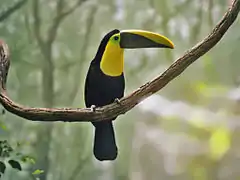 | Yellow-throated toucan | Ramphastos ambiguus | Central and northern South America |
Former species
Some authorities, either presently or formerly, recognize additional species or subspecies as species belonging to the genus Ramphastos including:
- Green aracari (as Ramphastos viridis)[3]
- Ivory-billed aracari (as Ramphastos Azara)[4]
- Black-necked aracari (as Ramphastos Aracari)[5]
- Black-necked aracari (atricollis) (as Ramphastos atricollis)[6]
- Collared aracari (as Ramphastos torquatus)[7]
- Saffron toucanet (as Ramphastos Bailloni)[8]
Description
This genus comprises the largest toucans, ranging from 42 to 61 centimetres (17 to 24 in) in length.[1] All have black wings, tails and thighs, but the colour of the remaining plumage depends on the exact species involved.
Diversity of bills
 Keel-billed toucan
Keel-billed toucan
(Ramphastos sulfuratus)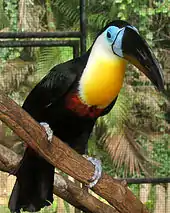 Channel-billed toucan
Channel-billed toucan
(Ramphastos vitellinus vitellinus)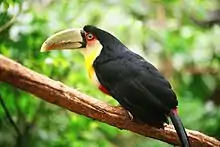 Green-billed toucan (Ramphastos dicolorus)
Green-billed toucan (Ramphastos dicolorus) Chestnut-mandibled toucan
Chestnut-mandibled toucan
(Ramphastos ambiguus swainsonii)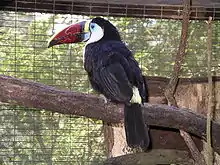 White-throated toucan, (Ramphastos tucanus)
White-throated toucan, (Ramphastos tucanus)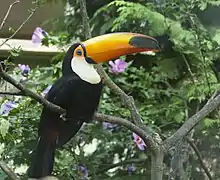 Toco toucan
Toco toucan
(Ramphastos toco)
Distribution and habitat
They are essentially resident birds, but may take part in minor, local movements (e.g., to lower altitudes in the winter).[1]
Behaviour and ecology
Breeding
They are arboreal and nest in tree holes laying 2–4 white eggs.
Food and feeding
All the species are basically fruit-eating, but will take insects and other small prey.[1]
Threats
The ischnoceran louse Austrophilopterus cancellosus is suspected to parasitize all species of Ramphastos toucans. Its presence has been confirmed on all species except the citron-throated toucan.[9]
References
- Short, L. L., & Horne, J. F. M. (2002). Toucans (Ramphastidae). pp. 220–272 in del Hoyo, J., Elliott, A., & Sargatal, J. eds. (2002). Handbook of the Birds of the World. Vol. 7 Jacamars to Woodpecker. Lynx Edicions, Barcelona. ISBN 84-87334-37-7
- "Jacamars, puffbirds, toucans, barbets & honeyguides « IOC World Bird List". www.worldbirdnames.org. Retrieved 2016-12-31.
- "Pteroglossus viridis – Avibase". avibase.bsc-eoc.org. Retrieved 2016-12-26.
- "Pteroglossus azara – Avibase". avibase.bsc-eoc.org. Retrieved 2016-12-26.
- "Pteroglossus aracari – Avibase". avibase.bsc-eoc.org. Retrieved 2016-12-26.
- "Pteroglossus aracari atricollis – Avibase". avibase.bsc-eoc.org. Retrieved 2016-12-26.
- "Pteroglossus torquatus – Avibase". avibase.bsc-eoc.org. Retrieved 2016-12-26.
- "Pteroglossus bailloni – Avibase". avibase.bsc-eoc.org. Retrieved 2016-12-27.
- Price, Roger D. & Weckstein, Jason D. (2005). The genus Austrophilopterus Ewing (Phthiraptera: Philopteridae) from toucans, toucanets, and araçaris (Piciformes: Ramphastidae). Zootaxa 918: 1–18. PDF fulltext
External links
| Wikimedia Commons has media related to Ramphastos. |
| Wikispecies has information related to Ramphastos. |
- List of Toucans
- Toucan videos on the Internet Bird Collection